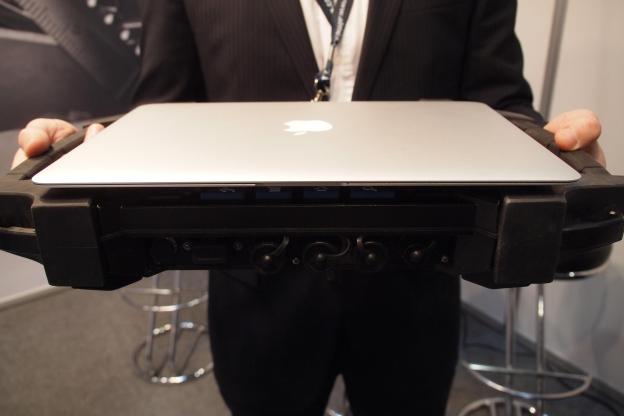If you’ve ever wondered what an Android tablet would look like if it were carried by Robocop, then you’ve come to the right place. We passed by the AlmexPad at the show this week and couldn’t take our eyes off it. Though it’s a relatively modest dual-core 10-inch slate, everything else about it is anything but ordinary. Originally built for miners in the rubber industry, this tablet is made for the harshest and oddest conditions you can imagine.
Updated by Jeffrey Van Camp on 2-28-2014: The folks at Almex clarified that the tablet at the show was a demo unit only running Android 2.3 on a single-core processor. The real deal will be quad-core and much faster. I also added a little more about how it’s used in mining.
The AlmexPad weighs 9.1lbs and has more surface area than a 13-inch MacBook Air.
The AlmexPad we saw is already being used in Argentinean and Australian mines and came loaded with special software to help manage the rubber vulcanization process – something we never thought we’d learn about writing for DT.
“The original tablets were designed for Conveyor Belt Splicers (both lightweight, and heavyweight fabric-core or steel cord belts), along with Conveyor System maintenance crews at mines, ports, and quarries,” said Kyle Booth, CTO & Global Products Manager for Almex Industries. “We have had great interest from the WMC in the new sectors we are approaching such as the first responders, military, agriculture, and other remote field service teams.”
The tablet itself weighs 9.1lbs and has a front surface (minus the handles) larger than a 13-inch MacBook Air, as you can see below and has a myriad of sensors, ports, and other special functions so it can better serve people in the elements, like miners, police, firefighters, factory workers, and others. It’s magnesium enclosure also has a nanocoating that can protect it from grease, oil, water, and other substances.

The demo unit we saw ran Gingerbread 2.3 on a 1GHz Freescale i.MX53 single-core ARM Cortex-A8 processor at only 1GHz, which explains why it’s slow as molasses, but the final unit will be “much faster,” according to Almex, featuring a fast 1.2GHz quad-core processor and Android 4.0.
The 1024 x 768 pixel screen on the demo unit is also a little underwhelming, partially because of its infrared touch panel. Infrared touch screens are used on Kindles and Nooks, but rarely on tablets and phones, which usually feature capacitive touchscreens activated by your body’s natural electricity. Unfortunately, capacitive screens are unsuitable for miners and workers who wear gloves and work in more extreme temperatures than we see on an ordinary day.
It also has a 7800mAh hot swappable battery, a second 2550mAh internal battery, 5-megapixel rear camera, fingerprint scanner, SD card slot, ruggedized external ports for USB/HDMI/Ethernet, Wi-Fi, Bluetooth, and the screen is viewable in direct sunlight.

Did we mention that there’s a built-in flashlight? Rest assured, it’s a lot bigger than that puny flash on your iPhone. There are six heavy-duty LED lights on the back of the AlmexPad Senior (the name of the 10-inch model), and they are bright enough to light up any tunnel.
At a total price of 5900 euros, we are hopeful the final product’s insides will match its durable body. The new version with a quad-core processor, NFC, a front camera, gyroscope, inductive charging, 4G LTE, RFID, dual-SIM support, and a resistive touch screen is coming soon.
If you happen to work in an extreme job, or have 5900 euros to kill and want a tablet so tough it could be used as a weapon, read more about the AlmexPad at Almex.com. A 7-inch version of the pad is also available, but it does not have the badass LED lights.
Originally published on 2-27-2014.
Editors' Recommendations
- The best Android tablets in 2024: the 11 best ones you can buy
- Google Chrome is getting the Android tablet update you’ve been waiting for


